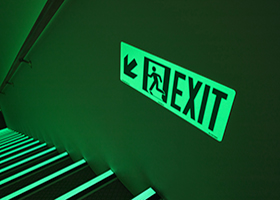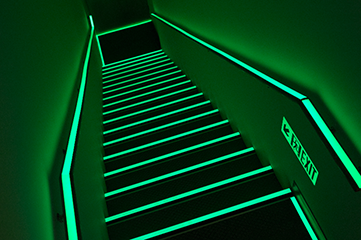Egress Pathmarking Systems: Photoluminescent Lifelines to Safety
Posted by Geoffrey Peckham | 1st Aug 2016
 When people need to escape from a building due to an
emergency situation, every passing moment matters. Whether it’s a fire,
earthquake or other crisis, each second can mean the difference between life
and death. Clearly communicating proper evacuation paths is essential to achieving
high speeds of egress – which is critical to the goal of saving lives in times
of crisis.
When people need to escape from a building due to an
emergency situation, every passing moment matters. Whether it’s a fire,
earthquake or other crisis, each second can mean the difference between life
and death. Clearly communicating proper evacuation paths is essential to achieving
high speeds of egress – which is critical to the goal of saving lives in times
of crisis.
Egress pathmarking systems are the guidelines that allow people to properly orient themselves in a facility in power-out conditions, giving them not only a visible idea of the space they are in but an accurate idea of the evacuation route out of the building. Safety signs and markings that incorporate safety-grade photoluminescent pigments represent the state-of-the-art of egress pathmarking technology. Clarion’s industry-leading egress pathmarking products are fail-safe – charged by ambient light, they will be visible for hours. In various emergency situations, they work as follows:
- Normal lighting conditions – when the lights are on, people use both the traditional high-located exit signs and low-located egress pathmarking components to discern the path to safety.
- Emergency lighting conditions – if or when the battery-operated lights attached to traditional high-located exit signs or mounted on walls go on because of a power failure, the low-located egress system components begin to become even more visible. ( Read more about "fail-safe" photoluminescence versus “failure-prone” electrical backup systems.)
- Lights-off and/or smoke conditions – when the lights go out or smoke fills the air, the high-tech phosphor pigments of the low-located photoluminescent products create bright, glowing lines to follow – to place your hand or to place your foot. And the system’s signs provide sure directional guidance.
It’s in lights-off conditions when the benefit of photoluminescence becomes clear – if the right pigments are used, that is. Clarion understands that it’s highly important to use pigments that have very high initial brightness because it takes anywhere from eight to 10 minutes for a person’s eyes to go from photopic vision (the vision of the eye under well-lit conditions) to scotopic vision (the vision of the eye under low-light conditions) or, in layman's terms, to become “dark-adapted.” If the egress markings are anything less than bright, your confidence of movement is hindered. You need to be able to immediately know where to place your hand on a handrail or your foot along a path or on a step.

And that’s why it’s necessary that egress system components be made from photoluminescent pigment mixtures that yield both high initial luminance AND longevity. Again, in layman’s terms, these markings need to glow brightly right off the bat, and they need to be able to be seen by the dark-adapted eye for hours after the lights have gone off. The characteristics of the pigments used in the photoluminescent safety products Clarion sells have such a balance, giving people confidence of movement in power-out conditions. And that leads to the most valuable thing in emergency situations: fast speeds of egress that save lives from tragedy.
Geoffrey Peckham
CEO, Clarion Safety Systems

This blog is part of a series of regular posts from our CEO, Geoffrey Peckham, to share his insight. Geoffrey serves as chair of the ANSI Z535 Committee for Safety Signs and Colors and chair of the U.S. TAG to ISO/TC 145 – Graphical Symbols. He has also been selected as a member of the U.S. TAG to ISO/PC 283, an ISO committee writing a new standard, ISO 45001 Occupational Health and Safety Management Systems, which will, when finished, define global best practices for workplace safety. In addition, he is an active member of many industry-specific standards committees related to safety signs and labels for buildings, ships, machinery and products.